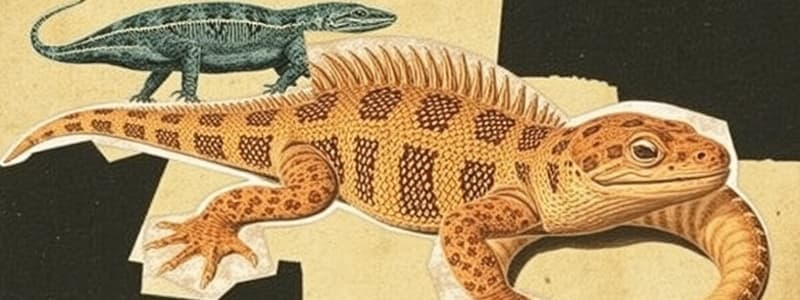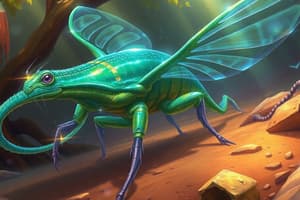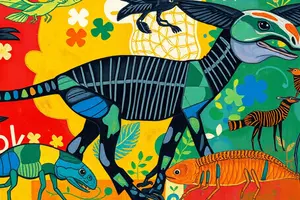Podcast
Questions and Answers
Which characteristic distinguishes vertebrates from invertebrates?
Which characteristic distinguishes vertebrates from invertebrates?
- Protective skin.
- Presence of muscles.
- Absence of a nervous system.
- Internal skeleton. (correct)
Which habitat is least likely to be inhabited by reptiles?
Which habitat is least likely to be inhabited by reptiles?
- Polar ice cap (correct)
- Desert
- Wetland
- Forest
What adaptation primarily enables fish to live in water?
What adaptation primarily enables fish to live in water?
- Cold-bloodedness
- Scales on their skin
- Gills for breathing (correct)
- Laying eggs
Which of the following is a key characteristic of amphibians that allows them to thrive in both terrestrial and aquatic environments?
Which of the following is a key characteristic of amphibians that allows them to thrive in both terrestrial and aquatic environments?
What structural adaptation do birds have that directly aids in their ability to fly?
What structural adaptation do birds have that directly aids in their ability to fly?
Which unique trait classifies whales as mammals despite living in water and lacking fur?
Which unique trait classifies whales as mammals despite living in water and lacking fur?
What is the primary function of the backbone in vertebrates?
What is the primary function of the backbone in vertebrates?
How do reptiles primarily regulate their body temperature?
How do reptiles primarily regulate their body temperature?
Which of the following characteristics is shared by both fish and reptiles?
Which of the following characteristics is shared by both fish and reptiles?
How does the skin of amphibians differ from that of reptiles?
How does the skin of amphibians differ from that of reptiles?
Which of these is an adaptation that allows amphibians to thrive in both land and water environments?
Which of these is an adaptation that allows amphibians to thrive in both land and water environments?
What characteristic is exclusive to mammals?
What characteristic is exclusive to mammals?
If an animal is warm-blooded, has feathers and wings, and lays eggs, how would it be classified?
If an animal is warm-blooded, has feathers and wings, and lays eggs, how would it be classified?
If an animal is found to have an internal skeleton, muscles, and blood circulating through vessels, to which group does it likely belong?
If an animal is found to have an internal skeleton, muscles, and blood circulating through vessels, to which group does it likely belong?
How does living on land affect the reproductive strategy of reptiles compared to fish?
How does living on land affect the reproductive strategy of reptiles compared to fish?
What is one of the primary challenges faced by amphibians due to their scaleless skin?
What is one of the primary challenges faced by amphibians due to their scaleless skin?
A wildlife biologist discovers a new species of animal. The animal has dry skin with scales, lays eggs on land, and is cold-blooded. How would this animal be classified?
A wildlife biologist discovers a new species of animal. The animal has dry skin with scales, lays eggs on land, and is cold-blooded. How would this animal be classified?
How does the habitat of birds influence their physical adaptations, particularly in terms of bone structure?
How does the habitat of birds influence their physical adaptations, particularly in terms of bone structure?
If a mammal is observed living primarily in aquatic environments and giving birth to live young, which additional characteristic would confirm its classification as a mammal rather than a fish?
If a mammal is observed living primarily in aquatic environments and giving birth to live young, which additional characteristic would confirm its classification as a mammal rather than a fish?
Why is it important for amphibians to live near bodies of water?
Why is it important for amphibians to live near bodies of water?
Flashcards
What are vertebrates?
What are vertebrates?
Animals that possess a backbone or spinal column.
What are invertebrates?
What are invertebrates?
Animals that do not have a backbone or spinal column.
What are reptiles?
What are reptiles?
Cold-blooded vertebrates covered with dry scales.
What are fishes?
What are fishes?
Signup and view all the flashcards
What are amphibians?
What are amphibians?
Signup and view all the flashcards
What are birds?
What are birds?
Signup and view all the flashcards
What are mammals?
What are mammals?
Signup and view all the flashcards
Study Notes
- Animals are classified into vertebrates and invertebrates
Vertebrates
- Animals possessing a backbone
- Examples include fish, amphibians, reptiles, birds, and mammals
- Key features: Internal skeleton, muscles, protective skin, blood circulating through vessels, and an advanced nervous system
- Backbone is for support and movement
Invertebrates
- Animals lacking a backbone
- Examples include sponges, jellyfish, worms, insects, earthworms, butterflies, and octopuses
Reptiles
- These are cold-blooded vertebrates covered in dry scales
- Examples include snakes, lizards, crocodiles, and turtles
- Characteristics include being cold-blooded, having dry, scaly skin, laying eggs on land, and living on land and in water
- Reptile habitats are water, wetlands, forests and deserts
Fish
- Cold-blooded aquatic animals possessing gills for breathing and fins for movement
- Aquatic animals live in water
- Examples include sharks, tuna, trout, catfish, and salmon
- Key traits: Being cold-blooded, living in water, breathing through gills, moving with fins, and laying eggs
- Fish habitats: rivers, oceans, lakes, and streams
Amphibians
- Animals that live part of their time on land and the rest in water
- They have webs on their legs for swimming
- Examples include newts, salamanders, frogs, and toads
- Key characteristics include being cold-blooded, living on land and in water, having scaleless skin, breathing through their skin in water, having webbed feet, and laying eggs in water
- Amphibian habitats are water, land, muddy water and wetlands
Birds
- Birds are warm-blooded, have feathers, and wings
- Hollow bones allow birds to fly
- Examples include sparrows, crows, pigeons, hawks, eagles, woodpeckers, and cranes
- Key characteristics include having hollow bones, feathers, wings, and laying eggs, as well as the ability to fly
- Habitats for birds are trees, water, land, and cliffs
Mammals
- Warm-blooded animals with fur and give birth to live young
- Examples include humans, cows, whales, goats, cats, tigers, bears, and dogs
- Mammal characteristics include being warm-blooded, having fur, giving birth, and suckling their young
- Mammal habitats include forests, sheds and water
Exceptions
- Reptiles and amphibians both live on land and in water, but reptiles have scaly skin, while amphibians have scaleless skin. Reptiles lay eggs on land, while amphibians lay eggs in water
- Whales live in water, lack fur, but are still classified as mammals because they give birth to live young
Studying That Suits You
Use AI to generate personalized quizzes and flashcards to suit your learning preferences.




